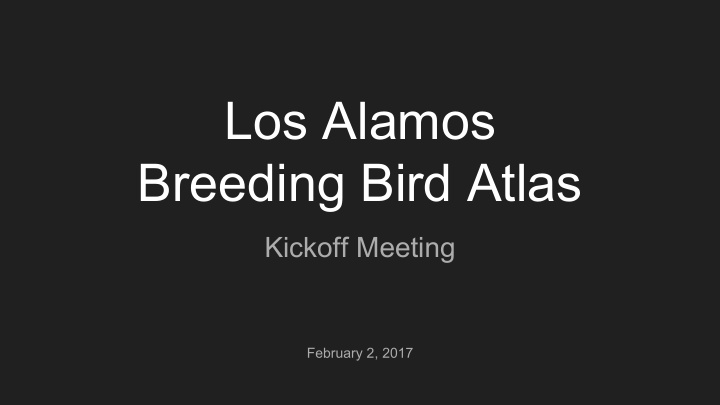



Los Alamos Breeding Bird Atlas Kickoff Meeting February 2, 2017
What is a Breeding Bird Atlas? A breeding bird atlas is a comprehensive avifauna survey designed to reveal the distribution of breeding birds within a given geographical area. The area is divided up into square “blocks” of territory and a list of species identified as possible, probable, or confirmed breeding within each block is accumulated. The survey fieldwork is typically undertaken for several years. When the fieldwork campaign is complete, the results are compiled and published.
Atlas of the Breeding Birds of Los Alamos County Published in 1992, the original Atlas of the Breeding Birds of Los Alamos County was produced by local birders based on five years of fieldwork conducted between 1984 and 1988. A grid of sixty blocks, 2.5 kilometers on a side, was defined such that it encompassed the entire county. The results of five years of fieldwork were compiled into the book that has been a cornerstone for local birding for the last 25 years.
Changes to Bird Distributions Since the 1980s In the 30 years since the original Atlas’s data were accumulated, several significant changes in bird distribution have occurred locally. New: Eurasian Collared-Dove, White-winged Dove, Scaled Quail, and Sora Gone: Gambel’s Quail and Black-billed Magpie Additionally, the significant fires of 1996, 2000, and 2011 have caused dramatic changes in habitat which has undoubtedly caused disruptions in the distribution of many species. All of this leads to the conclusion that the original BBA is out of date and an update is called for!
A Second Breeding Bird Atlas for Los Alamos ● Fieldwork campaign will cover 2017-2021 Using the same grid 1 , breeding codes, and protocols as the original atlas ● ● Data from the second atlas will be directly comparable to the original The 1992 BBA involved fieldwork from 47 people! We need your help to collect the data over the next five breeding seasons. 1 The 1992 BBA left a small corner of the county along the river outside of the grid; the new Atlas will add a 61st block to include this area.
How BBA Fieldwork is Done 1) Go out birding 2) Add breeding code information to each species you find that is in reasonable breeding habitat for that species 3) Be aware of what grid block you are in at all times 4) If you are birding in an area that spans multiple blocks, report the best breeding code for each species for each block! 5) Communicate your checklist to Mike and/or Mouser in one of two ways: a) Share your eBird checklist(s) with the account named “la-bba” b) Use a BBA field card and physically hand them over to one of us
An Introduction to the Breeding Codes CONFIRMED BREEDING PROBABLE BREEDING NY -- Nest with young PE -- Brood patch/physiological evidence NE -- Nest with eggs NB -- Nest building* ON -- Occupied nest CN -- Carrying nest material* FL -- Recently fledged young T -- Territory held for 7+ days FY -- Feeding young C -- Courtship, display , or copulation FS -- Carrying fecal sac N -- Visiting probable nest site CF -- Carrying food A -- Agitated behavior** UN -- Used nest P -- Pair in suitable habitat DD -- Distraction display M -- Multiple (7+) singing males S7 -- Singing male present 7+ days POSSIBLE BREEDING S -- Singing male *Do not use for wrens, woodpeckers H -- In appropriate habitat **Does not include mobbing owls, etc.
Adding Breeding Codes to an eBird Checklist (if you use a computer to enter your checklists into eBird)
Adding Breeding Codes to an eBird Checklist (if you use a computer to enter your checklists into eBird)
Adding Breeding Codes to an eBird Checklist (if you use a computer to enter your checklists into eBird)
Adding Breeding Codes to an eBird Checklist (if you use the eBird mobile app to enter your checklists)
Sharing an eBird Checklist with the “la-bba” Account This can only be done on the computer! No ability to do this in phone app (yet?).
Sharing an eBird Checklist with the “la-bba” Account (if you use a computer to enter your checklists into eBird)
Sharing a Checklist Using the Paper Atlas Card
Finding Your Location on the Grid Go to the BBA webpage: http://losalamosnature.org/birding/bba/ There you can open a map in Google Maps on your phone that will plot your phone’s present location on the grid. You can also download a KMZ version of the grid for use in Google Earth. Clicking/tapping on any point within the grid will bring up a dialog showing the block number you clicked on which is how you should refer to the block in your reports.
Dealing with Hikes that Enter Multiple Blocks ● Separate checklists/cards for each block OR ● One checklist/card for the whole hike but put notes in each species’ details for the best breeding code found in each block crossed. Upper Water Canyon
Accumulating the Data Master list showing the results for all species in all blocks. Blocks containing significant amount of habitat in which a species is expected to breed are colored red for “expected.” As evidence of possible, probable, or confirmed breeding is documented, cells will be colored orange, yellow, or green, respectively.
The Website http://losalamosnature.org/birding/bba/
Recommend
More recommend